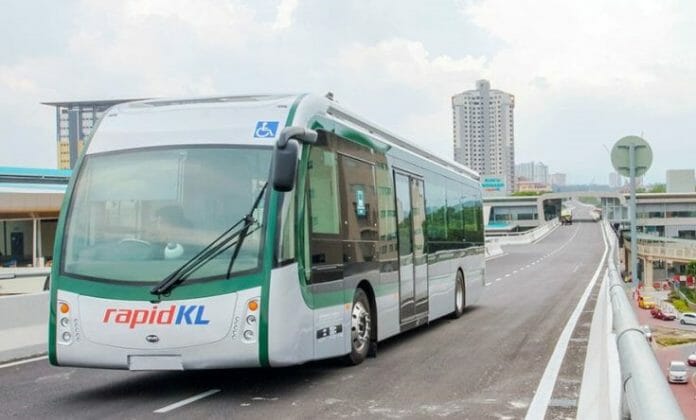It’s a truism that Kuala Lumpur is a very car-centric city. Over the years, the capital city had undergone structural planning developments in order to construct highly complex integrated road network systems comprising expressways (intra-conurbation highways) like Sprint (Western KL Traffic Dispersal System), LDP (Damansara-Puchong Expressway), NKVE (North Klang Valley Expressway), and NPE (New Pantai Expressway). This in addition to the (nearly) 60-year-old Federal Highway that links the western end of the Klang Valley (as represented by Klang and, by extension, Port Klang) with KL city centre.
However, the integrated road network systems principally catered to private transportation – as embodied by the toll booths. This meant that our public road transportation capacity has all the while been subordinated – in terms of policy priority or focus – to private ridership.
Inner and outer suburban areas are locked in between free-flowing roadways that create a natural geometric barrier that forces the buses to straddle around the commuting paths that are disruptive of the conception revolving around an efficient grid-based public transport system.
Instead of a re-thinking how public transportation could better integrate and synchronise with private transportation, the government chooses to emphasise building new expressways (such as the Petaling Jaya Dispersal Link/PJD and the Damansara–Shah Alam Elevated Expressway/Dash) and elevated inner and outer city rapid rail transits to address problems resulting from the neglect of the most basic first-and last-mile connectivity.
Traffic congestion has worsened since the country announced the shift to endemicity on April 1, 2022. According to the TomTom Traffic Index, the streets of Kuala Lumpur are 10% – 30% more congested today (depending on the period) than they were in 2019 during the pre-pandemic times.
Crowding in public ridership requires new expressways (toll free or not) to have dedicated bus lanes, for example.
Improving the Bus Network System in Klang Valley
The main reason why people choose to drive into the city, despite the billions poured into our public transportation system is simply because it’s not a convenient and comfortable alternative.
On December 1, 2015, the Land Public Transport Agency (Spad) under the Ministry of Transport (MOT) revamped the bus network system in Malaysia by reorganising the existing bus routes into 8 corridors.
The corridors were designated based on the main trunk roads that connect with Kuala Lumpur city center.
The main bus service provider within the Klang Valley area is Rapid Bus which commands a fleet of 1400 vehicles that comprises of their RapidKL, Go KL City Bus and MRT feeder buses. Currently, there are 179 routes that integrate with Klang Valley’s Rail Systems.
Buses are subject to the same roads and lanes as private vehicles and this harms their efficiency and punctuality for each trip.
Recently, Rapid Bus and DBKL launched a bus lane pilot project for the Jalan Ipoh corridor. The bus lanes would be in operation on weekdays from 6am to 8pm and would be free for all on the weekends and on public holidays.
However, what ended up happening was that the bus lanes fell victim to irresponsible double parkers and this forced buses to use the normal lane instead.
A practical solution to solve this is by establishing permanent bus lanes within the Klang Valley area where the bulk of the congestion lies.
Although the gridlock nature of the roads in Kuala Lumpur remains the biggest obstacle in implementing the bus lanes, it has been done before in other countries with even worse traffic conditions.
The TransMilenio is a bus rapid transit (BRT) that serves as the only form of public transportation in Bogota, Colombia. Bogota is known to have one of the heaviest road congestions in the world.
TransMilenio consists of several interconnected BRT lines, with raised floor stations in the centre of the main avenue (truncal). Passengers typically reach the stations via a bridge over the street. Usually, four lanes down the centre of the street are dedicated to bus traffic. The outer lanes allow express buses to bypass buses stopped at a station.
Instead of building more highways, Penalosa closed down lanes to give space for the buses to operate.
The results?
A 2 hour and 15 minutes for a 30 km journey by bus in 1998 now only takes 55 minutes by TransMilenio.
Towards that end, to mitigate the worsening traffic conditions and the over-reliance on private vehicles, EMIR Research suggests that the current administration revitalise the Greater Kuala Lumpur/Klang Valley Bus Transformation Plan that was introduced as an initiative under the National Key Results Area (NKRA) – Urban Public Transport (UPT).
But, firstly, the main reason why buses are underutilised stems from the inadequacy, unreliableness and inefficiency of the network to cater to consumer needs.
Towards that end, under the Greater Kuala Lumpur/Klang Valley Bus Transformation Plan, a BRT feasibility study had identified 12 bus corridors that would be used as the main reference point.
The whole Plan was expected to be executed in two phases starting with the Klang-Kuala Lumpur being the pilot corridor whereby the BRT route would pass through 3 main roads in Klang Valley with 39.5 km of designated busways and bus lanes coupled with 27 stations constructed along the Federal Highway which acts as the main connector between the two areas.
However, the Plan was cancelled and we have been left with an inconsistent and inconvenient bus system instead.
The cancelled BRT network would have been able to complement and supplement the existing rail transit system at that time by providing an alternative to address the first and last-mile connectivity problem.
A revitalised and enhanced BRT would see the supply curve shift to the right as the new routes would mean an influx of new buses for consumers to ride.
To further incentivise the consumption of buses as a means of commute, the government should also ensure that the current My50 scheme of a mere RM50 per month, i.e., low fare, and provides unlimited access to LRT, MRT, Monorail, BRT, Rapid KL buses, and Jom Naik MRT feeder buses be made tax-deductible for tax-payers.
A fully functioning and efficient public transport system shouldn’t heavily rely on the rail as the main proponent of alternative transport.
The initial Bus Transformation Plan would have cost around RM2 billion, approximately only 7% of the budget allocated for the development of MRT3.
This is for a 12-corridor network that would have seen improved connectivity and efficiency around Kuala Lumpur and the greater Klang Valley.
There is a need for a better BRT network especially now when congestion is looking unlikely to improve.
Taking the cue from South Korea also, which has one of the best public transport systems in the world where an aggregate total of 4 billion citizens use bus networks per year. The country achieved that by focussing on developing routes exclusively for public transportation purposes.
The bus system should be developed in a way that doesn’t only complement the existing rail transit system but also as a parallel public transportation partner that serves as an alternative to private vehicles.
Jason Loh Seong Wei and Rosihan Addin are part of the research team of EMIR Research, an independent think tank focused on strategic policy recommendations based on rigorous research.









